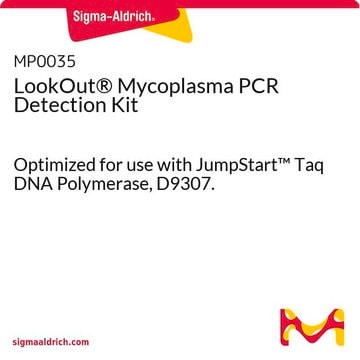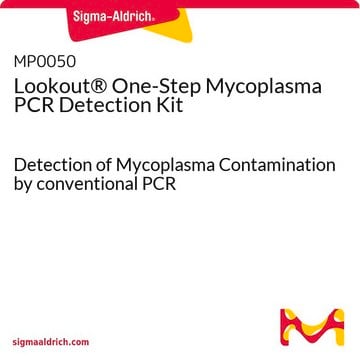MP0025
Venor™ GeM Mycoplasma Detection Kit, PCR-based
Synonim(y):
PCR mycoplasma detection kit
About This Item
Polecane produkty
zastosowanie
kit sufficient for 25 tests
opakowanie
pkg of 1 kit
warunki przechowywania
dry at room temperature
metody
PCR: suitable
Zastosowanie
detection
microbiology
temp. przechowywania
2-8°C
Opis ogólny
Zastosowanie
Komponenty
Przechowywanie i stabilność
Informacje prawne
Tylko elementy zestawu
- Positive Control
- Negative Control
- PCR 10X Reaction Buffer 500 mL/vial
- Primer/Nucleotide Mix 1 mL/vial
Kod klasy składowania
10 - Combustible liquids
Klasa zagrożenia wodnego (WGK)
WGK 3
Certyfikaty analizy (CoA)
Poszukaj Certyfikaty analizy (CoA), wpisując numer partii/serii produktów. Numery serii i partii można znaleźć na etykiecie produktu po słowach „seria” lub „partia”.
Masz już ten produkt?
Dokumenty związane z niedawno zakupionymi produktami zostały zamieszczone w Bibliotece dokumentów.
Klienci oglądali również te produkty
Produkty
Know when to use antibiotics to prevent bacterial or fungal, mycoplasma, or viral contamination in cell culture and find suitable antibiotics or other biological agents.
Wiedzieć, kiedy stosować antybiotyki, aby zapobiec skażeniu bakteryjnemu, grzybiczemu, mykoplazmowemu lub wirusowemu w hodowli komórkowej i znaleźć odpowiednie antybiotyki lub inne czynniki biologiczne.
Wykryj skażenie mykoplazmą w hodowli komórkowej za pomocą testów PCR, barwienia DNA lub hodowli. Odkryj zestawy do zapobiegania, eliminacji i wykrywania mykoplazmy.
Detect mycoplasma contamination in cell culture through the PCR, DNA stain, or culture tests. Discover mycoplasma prevention, elimination, and detection kits.
Protokoły
Mycoplasma contamination of cell cultures is a serious issue impacting cell model validity. PCR testing for mycoplasma is an inexpensive, sensitive, and specific method for detecting contamination.
Zanieczyszczenie hodowli komórkowych mykoplazmą jest poważnym problemem wpływającym na wiarygodność modeli komórkowych. Test PCR na obecność mykoplazmy jest niedrogą, czułą i specyficzną metodą wykrywania skażenia.
Nasz zespół naukowców ma doświadczenie we wszystkich obszarach badań, w tym w naukach przyrodniczych, materiałoznawstwie, syntezie chemicznej, chromatografii, analityce i wielu innych dziedzinach.
Skontaktuj się z zespołem ds. pomocy technicznej










